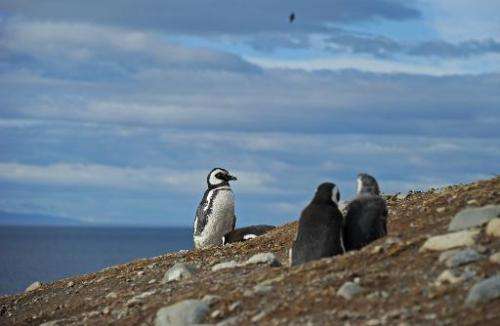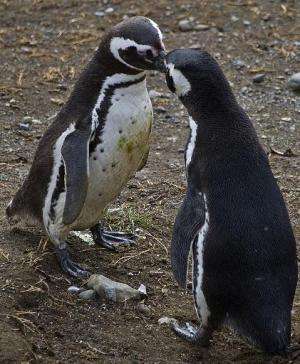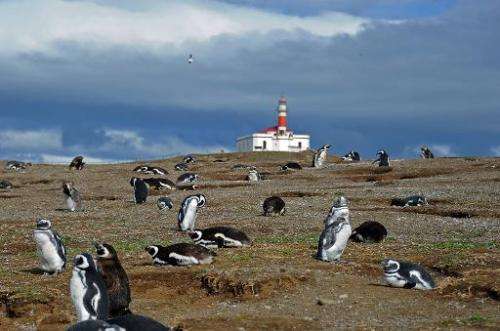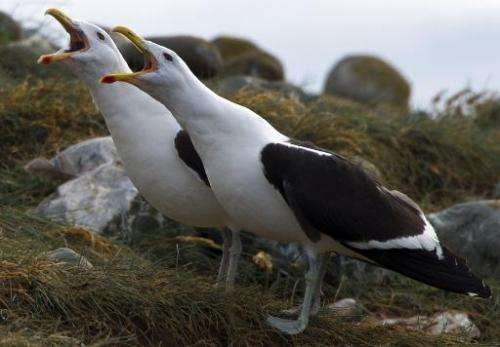Global warming a concern at Chile's penguin paradise

Magdalena Island, located near Chile's southern tip, is a natural paradise for tens of thousands of penguins who come every year to breed.
But global warming could threaten the long-term survival of the species, say experts at the island nature reserve in the Strait of Magellan, about 50 kilometers (30 miles) from the city of Punta Arenas.
The island is home to 22 bird species—11 which nest year-round and 11 seasonal visitors—including the Magellanic penguin.
Some 23,000 tourists a year make the pilgrimage to Los Pinguinos Natural Monument, a protected area comprising tiny Marta Island and windswept Magdalena Island.
The penguins' main predators are aggressive seabirds called skuas and Dominican gulls, which feed off penguin eggs and young, says Roberto Fernandez, a ranger at the site for the past seven years.
And those predator populations are growing.
"Right now, what we are seeing is summer starting late, then lasting through into March. Climate change is bringing about a rise in gull numbers, that is for sure," monument administrator Neftali Aroca told AFP.
"You would have to undertake a long-term study in order to link this increase with a reduction in the penguin population but the forecast is that in the future, the penguins could be at risk."

The worrying prognosis seems to confirm alarm bells sounded in January in a study published in the scientific journal PLOS ONE, which indicated that extreme weather, such as unseasonal warmth and heavy rainfall, may have killed off a considerable number of young Magellanic penguins.
The study—conducted over a period of 27 years in Argentina's Punta Tombo peninsula, the largest breeding ground for the species—showed that 65 percent of the colony's young died annually on average, 40 percent of them from hunger and seven percent owing to the effects of climate change.
Epic swim
Each year, the penguins flee the cold to spend winter in the warmer waters off Brazil.
As soon as they are big enough to swim, they head off on a 4,000-kilometer (2,500-mile) odyssey from Magdalena Island to Brazil.
They spend the Southern Hemisphere winter on the coast of Brazil's southern Santa Catarina state—though they sometimes make it as far up as Rio de Janeiro's beaches.
Come mid-August, they begin to head back, via Uruguay and Argentina to the Strait of Magellan, the natural passage between the Atlantic and Pacific oceans, and Magdalena Island.
"Magellanic penguins come to the island to complete their reproductive cycle," explains Valeria Sanchez, who has spent five years as a tour guide here.
"They start arriving in September, as summer approaches, to enjoy the longer days necessary to incubate their eggs and look after their young."

Family circles
The Magellanic penguins, who can live to 25, are monogamous, sharing their lives with just one partner.
First to arrive on Magdalena Island are the males, who must seek out the burrowed nests dug the previous season and make any necessary changes with whatever material they can find, including stones and feathers, before attracting their mate.
Around a fortnight later, the females arrive, and their keen partners sound a trumpet-like call to guide them to the nest.
The species tends to use the same burrow year after year to reproduce over a six-to-seven-month period.
Following fertilization, the females lay one or two eggs. For the first 12 days, she will incubate them and not leave them—even to eat.
Following their long fast, the mothers give way to the males in order to feed. The couples then switch at roughly fortnightly intervals until the end of the 40 to 45 day incubation period ahead of hatching in around November.

'Cup' refuge in Brazil
During the first months of their lives, the penguins' offspring are wholly dependent on their parents for food, learning to swim and how to fend off predators.
"Between February and March, they start to leave the island—but this year they began leaving two or three weeks earlier," Sanchez said.
"It seems they wanted to give themselves a head start to go and see the World Cup in Brazil," she joked, before explaining that the young had simply hatched early this year.
Journal information: PLoS ONE
© 2014 AFP


















